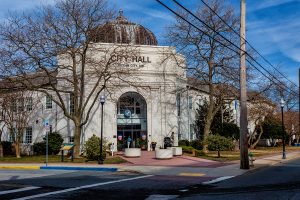
OCEAN CITY – Displaced last month by a planned office complex, an existing miniature golf course at 18th Street took an important first step this week to moving to a new location just one block north.
The Ocean City Planning Commission had before them on Tuesday an application for a conditional use in the Local Commerical-1, or LC-1, district for a miniature golf course. Last month, the planning commission approved a conditional use request for a new office complex for the Harrison Group on the site where the existing Nick’s Mini Golf course has existed for eight years.
The golf course owner has since purchased a property on the west side of 19th Street owned for years by the Phillips family and desires to move the existing golf course in a new and improved fashion to the block just to the north, but it requires a conditional use approval in the LC-1 zoning district. Zoning Administrator Kay Gordy explained the situation to the planning commission.
“He has had a Jurassic miniature golf course at 18th Street since 2013 and the company does have other courses,” she said. “The Harrison Group office development is causing the relocation of the mini-golf course. He is requesting a conditional use to essentially move the course one block to the north.”
Gordy explained the staff recommended approval for the requested conditional use based on site plan approval from the planning commission, an approved lighting plan to insulate nearby residential areas, and a noise control plan for the same reasons.
The proposed site for the relocated mini-golf course was formally a parking lot owned by the now-defunct Phillips Crab House on the opposite side of Philadelphia Avenue, although a new restaurant exists on the property. Gordy explained the mini-golf course owner, Dolphin Street Development of OC LLC and its principal owner Nick Geracimos, had obtained the property from Phillips and the settlement had already occurred.
Attorney Hugh Cropper represented Geracimos, who told the planning commission he has owned and operated multiple Nick’s Mini Golf courses in Ocean City, Fenwick Island, Bethany Beach and Dewey Beach, for example. He told the commission he desired to move his Jurassic course from its existing location at 18th Street to the new location at 19th Street.
“It all began with a tropical Key West mini-golf experience, but when we added dinosaurs, it really took off,” he said. “I was at 18th Street for eight years. The clientele really changed my image of what mini-golf should be.”
Geracimos said the situation with the development of the Harrison Group office on his former site was an opportunity to create an even better mini-golf experience at his new location at 19th Street.
“This is taking a situation and running with it to make an opportunity,” he said. “With my vast experience, moving this one block is the right thing to do. The 19th Street site is slightly bigger, so it gives me the opportunity to create something even better than the existing course.”
Geracimos said the proposed location at 19th Street offered more in terms of setbacks, buffers from the neighboring residential areas and pedestrian safety. There is also an existing crosswalk and traffic signal at 19th Street. Geracimos said the majority of his clientele were families.
“I’d say the percentage of families is 90% of all of our groups,” he said. “My objective is to really embrace those families even more. With the slightly large space, the holes are a little better spaced to improve the family experience.”
Parking is always a central concern with any new proposed development project. The town’s code for mini-golf courses requires one parking space for each of the 18 holes. However, it was determined the proposed relocation of golf course to 19th Street afforded the developer 23 parking spaces on site, or a surplus of five, so parking was not an issue for the project specifically, although there were some concerns about losing the parking lots that had been owned by Phillips for years.
Geracimos said the traffic control devices at the intersection, along with the opportunity for wider sidewalks represented an improvement over the course’s current location at 18th Street.
“We get a lot of walking traffic,” he said. “I think about 80% of our business is walk-up traffic. There’s a huge crosswalk and a signal at the intersection. It will be way more accessible to walk to the new location.”
Geracimos proactively and systematically addressed potential concerns from the planning commission and the neighboring residential areas during the presentation. In terms of lighting, he explained the new course would be able to use less lights in general and direct them onto the course.
In terms of background music and noise, Geracimos explained the new course would move away from a few large speakers for music and would rather have multiple, smaller speakers spread throughout the course with the sound directed at the holes and not neighboring properties.
“The plan is to have as much as a buffer as possible with the residential areas,” he said. “With the neighbors on the back side, I purposely limited the holes back there and concentrated them in the front section. There will be a fence around the entire perimeter, and it will be landscaped.”
With the applicant’s presentation complete, the planning commission opened the public hearing. While there was a smattering of public comments, none were opposed to the concept of moving the mini-golf course to 19th Street. However, there were some concerns raised about the impact of on-street parking, particularly in the neighboring residential areas.
Acting planning commission chair Palmer Gillis first asked if anyone who wished to speak was opposed to the project. First up was neighboring property owner Alfred Harrison, who said he was not opposed to the project but had some questions and concerns.
“I’d like to speak, but I don’t know that I’m in opposition,” he said. “We want to protect the R-1 values we have all bought into. That applicant has shown a great deal of understanding of the residential neighborhoods.”
Harrison questioned Geracimos and project architect Keith Fisher about specific technical design aspects of the proposed mini-golf relocation and it appeared his questions were answered to his satisfaction.
Neighboring business owner Shawn Harman spoke in favor of the project, although he did voice some concern about parking along Herring Way and the potential impact.
“I’m wholeheartedly behind this project,” he said. “We are neighbors with three other golf courses in town and they are great neighbors to have. They shut down early and they are generally quiet.”
Harman pointed out the other uses that could be permitted on the property. Cropper later reiterated some of those potential uses including bars, taverns, outdoor cafes, and all manner of commercial uses.
“There are a lot worse things that could go on there,” said Harman. “I think it’s a nice buffer between the residential areas and the highway. I think it’s an amenity for the hotels across the street and the crosswalk and traffic signal will work perfectly.”
Business owner Doug Buxbaum spoke more about Geracimos than the project specifically.
“It’s been exciting to watch him for the last eight years,” he said. “He has grown not just as a young man, but as a business owner. I think he’s a fabulous asset to the town of Ocean City.”
There were a couple other speakers who were not necessarily opposed to the project but had concerns about the potential impact of overflow parking on the public streets in their neighborhoods. After the public hearing portion was closed, Cropper was offered a chance to respond to the comments. He said the focus of the hearing was on the conditional use application for the project but said Geracimos and Fisher had addressed many of the concerns from neighbors in the design.
“Those other issues are very important, and you can see the applicant has taken them seriously,” he said. “He wants to be a good neighbor for the area properties. They have taken everything into consideration.”
Cropper reiterated Harman’s point about what else could be approved on the property.
“It’s a great use when you look at everything else that could be allowed there,” he said. “It’s also a good location because of the stop light and the crosswalk.”
Planning Commissioner Joe Wilson made a motion to forward a favorable recommendation on the conditional use request to the Mayor and Council for approval, a motion the four-member commission approved unanimously. The next step is approval from the Mayor and Council on the conditional use, followed by a site plan review in front of the planning commission.
“I think it’s a benign use,” said Wilson. “I think the applicant did a good job at getting out in front of the issues that were brought up.”

